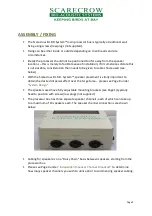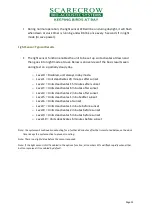
Independent Speaker Channel broadcast
•
The system incorporates three independent speaker channels.
•
Each speaker channel can accommodate up to a maximum of 10 speakers. The
system uses a 30w amplifier and therefore speakers need to be tapped down
according to the number of speakers (e.g. tapped down to 2.5w if the maximum 10
speakers are being used per channel) - the speaker channels do not broadcast at the
same time so 30w per channel is acceptable.
•
The broadcast is made out of each channel in turn, independently, and on a
randomised basis.
•
As with the variable volume, this is to provide the perception of predator movement,
to aid to the overall confusion and concern of the target specie, to improve dispersal
performance.
•
This feature works in conjunction with the variable volume.
•
In the event of a system design requiring say only 8 speakers, the choice exists to:
o
Use just one channel with all 8 speakers – in this instance all speakers will
broadcast at the same time, thus mitigating the effect of “predator
movement” by way of the sound sweeping from one set of speakers to
another.
o
Use 2 channels with say 4 speakers in each channel – in this instance the two
sets of 4 speakers will broadcast one after the other – so some “predator
movement” effect is obtained.
o
Use 3 channels with a split of speakers across the 3 channels – in this instance
the full effect of “predator movement” is obtained.
Note: The decision as to which option to follow may be driven by other factors such as
installation costing
.
Habitat Management
•
Whilst the unique efficiency of SCARECROW bio-acoustic products is long established
SCARECROW BIO-ACOUSTIC SYSTEMS LIMITED stress that they can only work
effectively as part of an overall and planned programme of bird control.
•
This will include total hygiene management and where applicable the use of
operatives who have been professionally trained.
•
Without limitation, SCARECROW BIO-ACOUSTIC SYSTEMS LIMITED will not accept
liability for any consequences as a result of poor equipment maintenance, misuse,
inappropriate use, lack of operative training, failure of due diligence or through lack
of prior project consultation.
Page 4





































